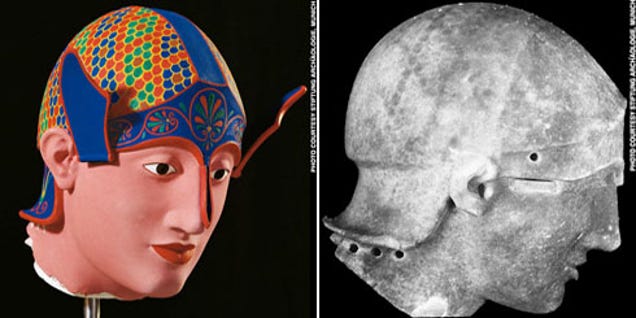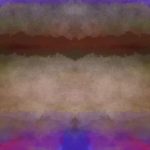Recent Forum Topics › Forums › The Public House › Ultraviolet light reveals how ancient Greek & Roman statues really looked
- This topic has 3 replies, 3 voices, and was last updated 7 years, 7 months ago by
 bnw.
bnw.
-
AuthorPosts
-
August 31, 2016 at 10:59 pm #51968
 znModerator
znModeratorUltraviolet light reveals how ancient Greek & Roman statues really looked
Original Greek and Roman statues, like Augustus, were brightly painted, but after thousands of years, those paints have worn away. Find out how shining a light on the statues can be all that’s required to see them as they were thousands of years ago.
Although it seems impossible to think that anything could be left to discover after thousands of years of wind, sun, sand, and art students, finding the long lost patterns on a piece of ancient Greek sculpture can be as easy as shining a lamp on it. A technique called ‘raking light’ has been used to analyze art for a long time. A lamp is positioned carefully enough that the path of the light is almost parallel to the surface of the object. When used on paintings, this makes brushstrokes, grit, and dust obvious. On statues, the effect is more subtle. Brush-strokes are impossible to see, but because different paints wear off at different rates, the stone is raised in some places – protected from erosion by its cap of paint – and lowered in others. Elaborate patterns become visible.
Ultraviolet is also used to discern patterns. UV light makes many organic compounds fluoresce. Art dealers use UV lights to check if art has been touched up, since older paints have a lot of organic compounds and modern paints have relatively little. On ancient Greek statues, tiny fragments of pigment still left on the surface glow bright, illuminating more detailed patterns.
Once the pattern is mapped, there is still the problem of figuring out which paint colors to use. A series of dark blues will create a very different effect than gold and pink. Even if enough pigment is left over so that the naked eye can make out a color, a few thousand years can really change a statue’s complexion. There’s no reason to think that color seen today would be anything like the hues the statues were originally painted.
There is a way around this dilemma. The colors may fade over time, but the original materials – plant and animal-derived pigments, crushed stones or shells – still look the same today as they did thousands of years ago. This can also be discovered using light.
Infrared and X-ray spectroscopy can help researchers understand what the paints are made of, and how they looked all that time ago. Spectroscopy relies on the fact that atoms are picky when it comes to what kind of incoming energy they absorb. Certain materials will only accept certain wavelengths of light. Everything else they reflect. Spectroscopes send out a variety of wavelengths, like scouts into a foreign land. Inevitably, a few of these scouts do not come back. By noting which wavelengths are absorbed, scientists can determine what materials the substance is made of. Infrared helps determine organic compounds. X-rays, because of their higher energy level, don’t stop for anything less than the heavier elements, like rocks and minerals. Together, researchers can determine approximately what color a millennia-old statue was painted.
The color? Always something flamboyant! September 1, 2016 at 9:24 am #51973
September 1, 2016 at 9:24 am #51973 bnwBlocked
bnwBlockedStill very subjective but in the right direction to recreate true history. Excellent article. Good find.
The upside to being a Rams fan is heartbreak.
Sprinkles are for winners.
September 1, 2016 at 11:31 am #51988 Billy_TParticipant
Billy_TParticipantInteresting, ZN.
My first degree’s minor was Art History. We touched very lightly on the colors of those statues, but it was there for us. Amazing how first impressions take hold, because from my aesthetic point of view, I’m moved more by the statues with the color faded away. My guess is that if I had grown up with the color, I would have preferred that, but who knows?
Then again, there is always that “acquired taste” thing. Prior to visiting Ireland, I wasn’t always so thrilled with seeing brightly colored homes or businesses in a row. After seeing them close up, and often, I grew to love them. Haven’t been to the Scandinavian countries, but they have a lot of that as well.
Colors done well. When it’s right, it fits in so much better with the environment . . . so it would be interesting to see those statues with their original colors in context. Again, when it comes to buildings, I really liked the way — rooftops, especially — they blended in so well with hills, mountainsides, the coasts in France. Mostly slate and a kind of amber color, and it was pretty universal in most towns in the South. Studying Cezanne more than prepared me for that, for that special kind of adaptation to the environment which is all too rare in America.
Too often our cities and towns seem to be an expression of conquering and exploiting surrounding nature, instead of harmonizing with it. Much of Europe was built with a different view of things.
September 1, 2016 at 2:33 pm #51991 bnwBlocked
bnwBlockedInteresting, ZN.
My first degree’s minor was Art History. We touched very lightly on the colors of those statues, but it was there for us. Amazing how first impressions take hold, because from my aesthetic point of view, I’m moved more by the statues with the color faded away. My guess is that if I had grown up with the color, I would have preferred that, but who knows?
Then again, there is always that “acquired taste” thing. Prior to visiting Ireland, I wasn’t always so thrilled with seeing brightly colored homes or businesses in a row. After seeing them close up, and often, I grew to love them. Haven’t been to the Scandinavian countries, but they have a lot of that as well.
Colors done well. When it’s right, it fits in so much better with the environment . . . so it would be interesting to see those statues with their original colors in context. Again, when it comes to buildings, I really liked the way — rooftops, especially — they blended in so well with hills, mountainsides, the coasts in France. Mostly slate and a kind of amber color, and it was pretty universal in most towns in the South. Studying Cezanne more than prepared me for that, for that special kind of adaptation to the environment which is all too rare in America.
Too often our cities and towns seem to be an expression of conquering and exploiting surrounding nature, instead of harmonizing with it. Much of Europe was built with a different view of things.
The US sw is an area where this can still be seen especially those buildings built with local resources taking the local climate into account before A/C became common. Frank Lloyd Wright’s Taliesin West is a high end example of that.
The upside to being a Rams fan is heartbreak.
Sprinkles are for winners.
-
AuthorPosts
- You must be logged in to reply to this topic.

